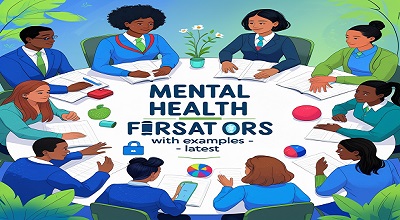Mental Health First Aid for Educators
Mental Health First Aid for Educators: A vital component of total wellbeing is mental health, particularly in educational environments where teachers and students deal with a variety of pressures. Teachers who possess Mental Health First Aid (MHFA) are better equipped to recognise, comprehend, and address mental health issues.
This thorough manual examines Mental Health First Aid for Teachers, including practical advice, real-world examples, and the most recent research to provide a nurturing learning environment.
Knowing how Mental Health First Aid (MHFA) works
The first assistance given to someone going through a mental health crisis or developing a mental health issue is known as mental health first aid. MHFA offers emergency care until professional assistance is available, just like physical first aid. Important Elements of MHFA: Identifying symptoms of mental health problems listening without passing judgment, supplying information and assurance promoting expert assistance, Encouragement of self-help techniques
The Need for Mental Health First Aid Training for Teachers
Teachers are first responders to mental health issues because they spend a lot of time with students. This is why MHFA training is so important: Advantages for Teachers: Early detection of difficulties related to mental health
✅ Less stigma associated with mental health
✅ Better interactions between students and teachers
✅ Better classroom management
✅ More assistance for children who are at risk
Data on the Mental Health of Students:
According to the CDC, 1 in 5 students suffer from a mental health illness. Secondly, according to the WHO, 50% of mental health disorders start by the age of 14. According to NAMI, the second most common cause of death for teenagers is suicide.
Essential Guidelines for First Aid in Mental Health:
Teachers should adhere to these ALGEE action plan principles to deliver successful MHFA: Determine the risk of harm or suicide. Listen without passing judgment. Provide information and reassurance. Promote expert assistance. Promote self-help and support techniques.
Typical Student Mental Health Concerns:
Teachers need to be aware of these common mental health issues:
A. Disorders of Anxiety Symptoms include avoidance behaviours, panic attacks, and excessive concern. For instance, a student who suffers from social anxiety steers clear of presentations.
B. Depression Symptoms include weariness, disinterest, and ongoing unhappiness. Example: A student who used to participate in extracurricular activities stops.
C. Hyperactivity/Attention Deficit Disorder
Symptoms include impulsivity, hyperactivity, and inattention.
Example: A bright student finds it difficult to concentrate.
D. Disorders of Eating Symptoms include binge eating, severe dieting, and issues with body image. For instance, a student who habitually misses lunch rapidly loses weight.
E. Post-Traumatic Stress Disorder, or PTSD, Symptoms include nightmares, emotional numbness, and flashbacks. For instance, a student who has experienced trauma in the past may respond violently to loud noises.
A Comprehensive Guide to Offering MHFA in Schools:
- Track Modifications in Behaviour
- A sudden drop in academic achievement
A rise in absenteeism, Social disengagement Step:
Have a Private Conversation with the Student. Ask open-ended questions, such as “I’ve observed that you haven’t been talking much recently.
Would you like to speak?
- Actively Listen Without Passing Judgment Steer clear of interruptions and unsolicited advise.
- Provide Resources and Support Put them in touch with mental health specialists or school counselors.
Monitor:
- In order to guarantee continued support, check in frequently.
- Actual Cases of MHFA in Learning Environments:
Managing a Panic Attack as an Example Situation:
Prior to an exam, a student has hyperventilation.
Action: The teacher reassures them, leads them to a peaceful area, and promotes deep breathing.
Example:
Helping a Depressed Student: A student shows signs of despair. Action: After listening to them sympathetically, the teacher refers them to the school psychologist.
Example: Handling Anxiety Associated with Bullying Situation: Because of bullying, a pupil is afraid to go to school. The educator takes action by implementing anti-bullying policies and offering counselling assistance.
Taking Care of Your Own Mental Health as an Educator. For educators to effectively serve students, their own well-being must come first. Techniques for Self-Care: Establish sensible limits. Practice meditation and awareness. Seek therapy or assistance from your peers. Keep a healthy work-life balance.
Teacher Training Programs and Resources (www.mentalhealthfirstaid.org) Mental Health First Aid USA (www.nami.org) NAMI (National Alliance on Mental Illness) Enter “HOME” into the Crisis Text Line (741741) Programs for mental health education in schools
Final Thoughts:
Final thoughts: Teachers can save lives by learning Mental Health First Aid. Teachers have the power to change lives by identifying warning signals, providing sympathetic support, and putting students in touch with experts.
